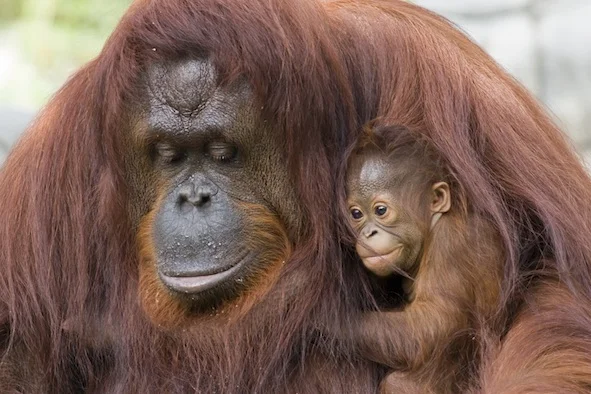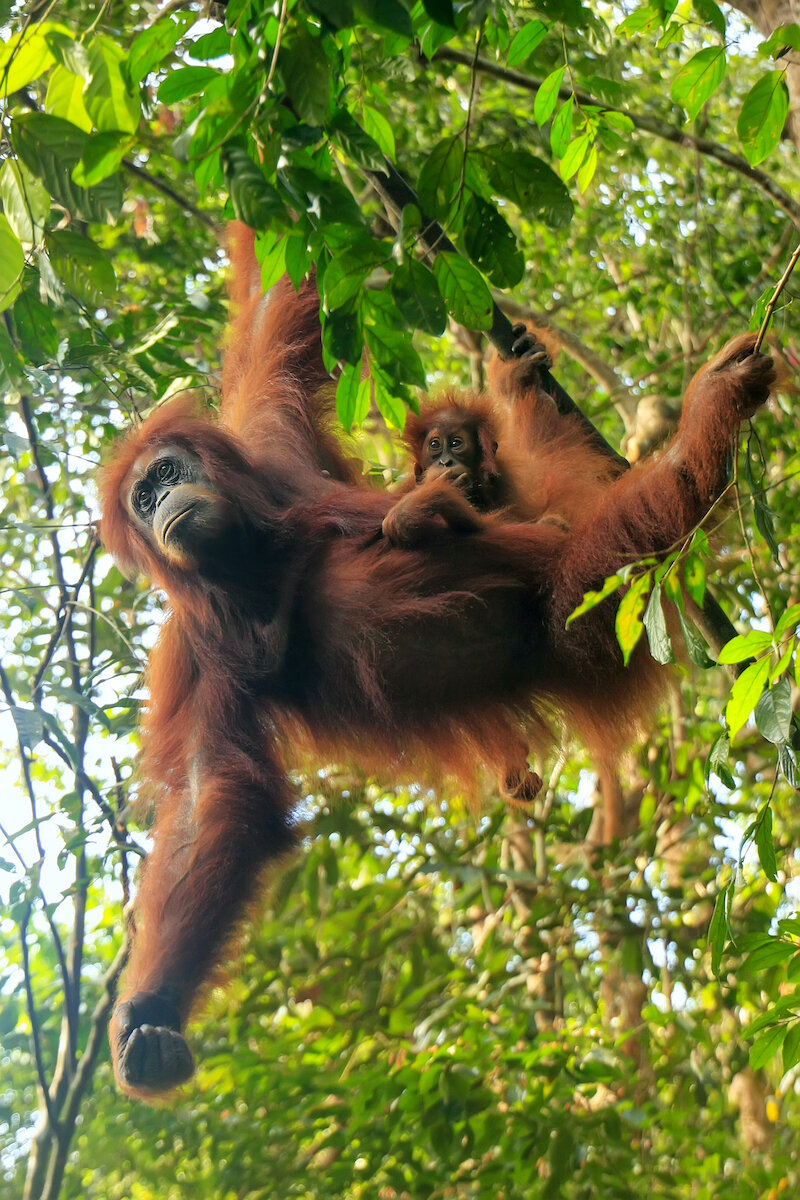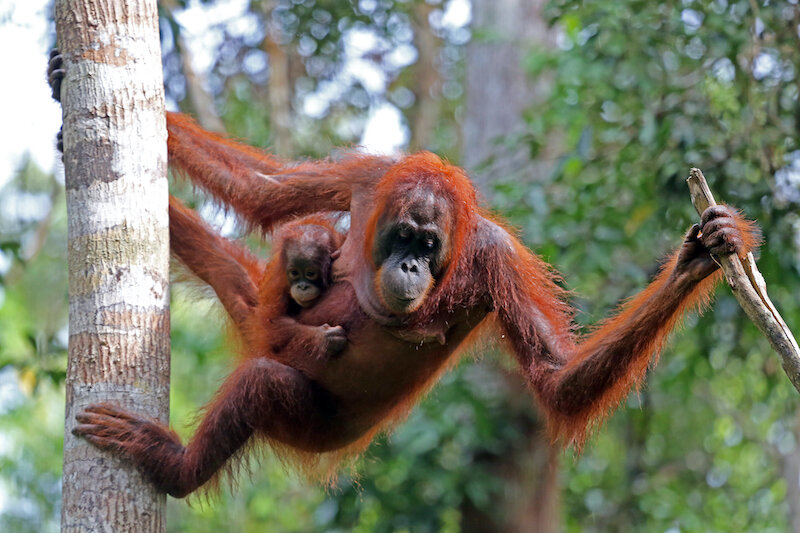Orangutans are big apes.
They live in trees in rainforests.
They have long arms and swing from tree to tree.
They hardly ever come down to the ground.
They eat mostly fruit, leaves and flowers.
Orangutans have long arms and can grip strongly with hands and feet. ©Getty Images
What is an orangutan?
The orangutan (say uh-rang-oo-tan) is one of the great apes. Apes are the largest of the primates, a family that includes humans.
Orangutans are the only apes found in Asia. They are very closely related to humans, and are the largest arboreal (tree-living) mammals.
There are just three species, or kinds, of orangutan, found only on the islands of Sumatra and Borneo. One of these species is newly discovered, called the Tapanuli orangutan, found in the far northwest of Sumatra. All are critically endangered.
Habitat and Distribution (where they are found)
Orangutans live in the oldest rainforests in the world, and only on the islands of Borneo and Sumatra. The word 'orangutan' means 'person of the forest'.
Orangutan habitat - the oldest rainforests in the world, on Borneo and Sumatra. ©Getty Images
Body and Appearance
Orangutans are covered with long red hair, the only apes that have red fur.
Bornean male orangutan. ©Getty Images
Adult males weigh about 144 kilograms, and the females weigh about 65 kilograms. Adult males have large cheek flaps on their faces. They have a sac under their chins which they inflate with air to make a long call that can be heard about a kilometre away.
They rarely come down from the trees, and have long, strong arms for swinging through the branches from tree to tree. This way of travelling is called 'brachiation'. Their feet are like hands, to help this movement through the treetops. An adult orangutan's stretched-out arms measure over 2 metres, fingertip to fingertip!
A baby clings to its mother as she climbs through the trees.©Getty
Sumatran orangutans have lighter-coloured fur and a longer beard. Bornean orangutans have narrower cheek pads.
The Sumatran orangutan is smaller than the Bornean and has a longer face and lighter, longer coat.
The newly discovered species of orangutan, the Tapanuli orangutan, has a smaller skull than the Bornean and Sumatran orangutans, but has larger canine teeth. Mature males have cheek flaps similar to those of Bornean orangutans, but their slender build is more like that of Sumatran orangutans. Their hair is more cinnamon in colour than the Bornean species, and one group around Batang Toru makes longer calls than other orangutans.
Behaviours
Male orangutans spend almost all their time alone. Females are accompanied by their young. When wild fig trees are in fruit, orangutans do share feeding at the same trees, but at other times they are alone. Males and females only meet in order to mate.
A baby orangutan looks at the world while safely clinging to its mother. ©Getty
Orangutans rarely come to the forest floor, and are rather slow and awkward when they do, moving on all fours. They build a fresh nest each night, high up in a tree. Sometimes they make an umbrella of leaves over the nest if it is raining.
Orangutans are gentle and highly intelligent animals. They use tools to help them get food, for example, using a stick to reach into a beehive to get honey. They have excellent memories, and remember where to go in the forest at different seasons to find trees bearing fruit.
Diet
An orangutan feeding in a tree, Borneo. ©Getty
Orangutans eat mostly fruit. Much of their time is spent eating because a mainly fruit diet doesn't give a lot of energy to such large animals and they need to eat big quantities to get nutrition. Wild figs and durians are their preferred food. However, they do also eat roots, nuts and berries, insects, reptiles, eggs, bark and leaves.
Orangutans help the rainforests by dispersing seeds. As they move through the forest eating fruit, they spread the seeds in their poo in different parts of the forest, and the seeds grow into fruit trees.
Life Cycle
A young orangutan finding food as it starts to venture short distances from its mother ©Getty Images
In the wild, orangutans live for about 35 years, longer in captivity. Male orangutans are about 15-20 before they are large enough to successfully compete for females. Females only breed every 7-8 years because the young depend on their mothers for about 8 years. Females give birth to one young, rarely twins, about 8-9 months after mating. For its first year, the young orangutan clings to its mother and suckles milk from her. The young are fully grown at about 10-12 years, by which time they begin to live independently .
Conservation status and threats
Orangutans are Critically Endangered and are seriously in danger of becoming extinct in the wild in a very few years:
Habitat is fast being destroyed. About 80% of the rainforest has gone. Logging for timber is one reason. Rainforest does not regrow quickly: some trees take 60 years to reach maturity and 200 years to reach full height.
Palm plantations are planted where rainforest has been cut down: palm oil is in great demand by the western world. It is a major ingredient in soaps, shampoos and processed foods. When a habitat is destroyed, many animal species are left without shelter and food, for example in Sumatra the ancient rainforest is habitat to rare tigers, rare rhinoceros, many species of monkey, among many other small species of animal, reptile, insects, as well as rare plants.
New and more established palm oil plantations across a landscape… in the distance, top of picture, there is an area of remnant rainforest. ©Getty Images
An orphan Sumatran orangutan baby at a rescue centre. ©Getty Images
Orangutans give birth to one, rarely two, young every 8-10 years, which makes the job of increasing total wild populations more difficult.
The pet trade has also affected the orangutan population. The babies are very cute and poachers take them and sell them as pets. However, in a few years that baby is big and very strong and pet owners dump them in the forest, where they don't know how to survive.
A male at a feeding platform in a rainforest rescue centre where captive orangutans are gradually re-introduced to the wild. ©Getty
Rescue centres have been set up that teach orangutans that have been pets how to survive in wild, protected areas. They begin to move away as they learn how to find food for themselves.
Read more about orangutans and conservation efforts to save them:
http://wwf.panda.org/what_we_do/endangered_species/great_apes/orangutans/
Read about orangutans and about palm oil by choosing the palm oil tab :
What can I do to help conservation? I'm just a kid.
https://www.rickshawtravel.co.uk/blog/7-ways-to-help-save-orangutans/











